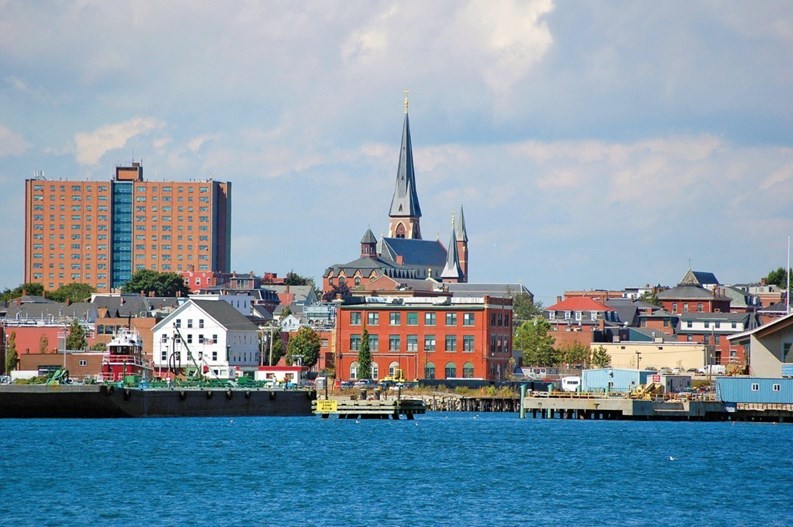Four million people visit Portland, Maine each year. But don’t picture lobster bibs and sunburned summer tourists. The largest city in Maine is not known for its fish shacks, candy stores or beaches. The center of both commerce and culture in Maine, Portland is a thriving small cosmopolitan city. With a world-class symphony and art museum, nationally-ranked restaurants, more than 40 languages spoken in the public schools, and industries from insurance to semi-conductors, Portland is an old city with a new beat.
The population of the city of Portland has remained astonishingly stable over the past 100 years. Census data lists 60,000 people living in Portland in 1910. Today, there are approximately 64,000 living within the city limits. However, nearly a quarter of Maine’s total population – 270,000 people –live and work in the greater Portland area.
One can still find notoriously crusty Mainers here – complete with thick accents, weathered faces and the belief that those who haven’t been in Maine for generations are “from away.” But one can also find new communities of residents from Africa, Eastern Europe and Southeast Asia. There are entrepreneursenticed by the burgeoning technology and service sectors. And there are many transplants who are more than willing to be considered “from away” simply to partake in Portland’s quality of life. Regularly appearing on lists of most livable cities and best cities for doing business, Portland’s charms are no longer a secret.
Old Business and New Business
Settled by the British in 1632 as a fishing and trading outpost, Portland’s identity has long been anchored by its “Old Port.” Portland became a major commercial port and shipping center in the middle of the eighteenth century. Weathering wars, storms, trade boycotts and fires, the port has been an integral part of Portland ever since. While no longer central to the economy, the citystill claims to have the largest tonnage seaport and the second largest fishing port in New England.
Although Portland’s waterfront and port are vital to the landscape and character of the city, the modern economy of Portland is largely fueled by service industries, explains Nora Kreisler of the Chamber of Commerce – most prominently tourism, insurance, financial services and medical services.
While there is still manufacturing, it is no longer the production of hats or shoes in the old factories that line the port, but the creation of semi-conductors and biotech products in technology parks. Portland has worked hard over the past decades to attract and develop these new businesses and industries. After suffering economic stagnation in the 1960s and 1970s, the city strove to balance economic growth and preservation in a deliberate, controlled and planned manner.
In 1991 the city formed the Downtown Portland Corporation (DPC) to help provide financing to businesses in Portland, with a focus on the downtown. Between direct financing and tax incentives, “the DPC has stimulated over $121 million in new investment and created or retained more than 5,300 jobs for Portland,” says Kreisler.
Today’s largest employers within the city limits include UnumProvident Insurance, the Maine Medical Center and the University of Southern Maine. In the greater metropolitan area, Hannaford Brothers supermarkets, Anthem Blue Cross Blue Shield, Fairchild Semiconductor, IDEXX Laboratories and National Semicon-ductor all contribute to Portland’s robust economy.
A City of Neighborhoods
Called Machigonne or Great Knee by the Native Americans who originally inhabited the land, Portland sits on a hilly peninsula overlooking the Casco Bay in Southeastern Maine. Although only 100 miles north of Boston, Portland’s coastal landscape and the islands dotting the bay could only be Maine.
Called “the beautiful town that is seated by the sea,” by native son HenryWadsworth Longfellow, Portland’s physical setting has always been one of its most compelling features. With beaches, woods, and mountains alluringly near, Portlanders don’t have to go far to exercise their love affair with the great outdoors.
In fact, in any season of the year residents can be seen enjoying the expansive network of pedestrian and bike trails that run throughout the city.
Portland lies on 26 square miles and is divided into distinct neighborhoods that spread out from the waterfront. While not political or economic entities, each neighborhood has a defining characteristic and is commonly knownand referenced by residents.
Downtown is a small area around Congress Street that includes the Old Port and the Arts District. Some of the adjacent residential neighborhoodsinclude Parkside, Bayside, West End, East End, and Munjoy Hill.
Despite being walking distance to downtown, most of these neighborhoods look and feel more suburban than urban; with backyards, old homes and quiet tree lined streets. Many of today’s residents live in the same Victorian, Federal and row homes that housed the population at the turn of the 20th century.
Looking for really old buildings? Don’t look too hard. Portland has earned the right to use the Phoenix rising from the ashes as its city seal. The seal alludes to the city’s numerous rebirths; first following Indian raids in the 17th century, again following bombardment by the English navy during the American Revolution, and most significantly, following a massive fire that was the unfortunate conclusion to a July 4th celebration in 1866.The fire destroyed the entire financial and trade center of the city and left more than 10,000 residents homeless. The consequence of the fire is evident in Portland’s architecture – which is largely brick, often Victorian and mostly dating from the last 150 years.
Preserving for the Future
Portland is determined to preserve these buildings for the future – the city’s Historic Preservation Departmentlists over 1,500 properties that are protected as individual landmarks. Thanks to this preservation effort that began in the 1970s, the port district is considered one of the most successful warehouse renewal efforts in the country.
Today, Portland’s Old Port is more than a dusty historic district; it is a popular destination for tourists and residents alike. Connected to a working waterfront, the 19th century buildings and warehouses currently are home to cutting-edge restaurants, apartments and boutiques. Labeled the “foodiest small town in America” by Bon Appetit Magazine in 2009, many of Portland’s truly excellent restaurants can be founddowntown.
In addition to dining and shopping, downtown Portland has a thriving art district. Just blocks from the port, the Arts District has numerous galleries and studios, as well as the Portland Museum of Art, the Children’s Museum of Maine, and the Institute of Contemporary Art. The latter is part of the Maine College of Art, oftencredited for being at the forefront of downtown’s renewal.
For performing arts, the Arts Districtoffers the Portland Stage Company and Merrill Auditorium, a 2,000-seat venue for concerts, opera and dance performances. Merrill, which recently received a $9.5 million renovation, is home to the Portland Symphony Orchestra and hosts acts as varied as bluesman B.B. King and comedian Jerry Seinfeld.
Many Condominium Conversions
According to Rick Blackburn of the Portland Assessor’s Office, there are close to 12,000 single family homes and just over 3,000 condominium units in Portland proper. The median sales price for a single family home is $215,000 and the median price for a condominium is $183,000. The market is down overall from the high in 2005, with condominium prices faring somewhatworse than single family homes.
John Herrigel, an associate realtor at Green Tree Realty who manages a website analyzing the Portland real estate market, notes, “The condominium market has dropped more than the single family market, but probably because the condominium market hadrisen a lot faster in the past.” Herrigel explains that there were many conversions in the past few years and new condominium complexes were built downtown, resulting in supply outpacing demand.
Numbers from the Assessor’s Office show that condominium inventory increased more than 20% since 2005, adding almost 600 units. In the same period, the number of single-family homes in Portland remained essentiallystatic.
The Multiple Listing Service showed205 condominiums on the market in Portland at the end of 2009. These ranged from an 750-square-foot, three-bedroom, one-bath for $90K to a five-bedroom, four-bath 4,000-square-foot “New York Style condo” in a converted nineteenth century building in the historic district for $1.2 million.
History is present and apparent as you walk the streets of Portland. But don’t let the cobblestones fool you; this city has preserved its history but it is absolutely not entrenched in the past. Making numerous “best of” lists including those for entrepreneurs, for families, for green living and for foodies, Portland has drawn a great deal of attention for being unexpectedly progressive and eminently livable. Withits blend of old and new, this funky little city is still a functioning port city – but a port city with a whole new groove.
Sarah Sanford is a freelance writer and regular contributor to New England Condominium magazine.







Comments
Leave a Comment